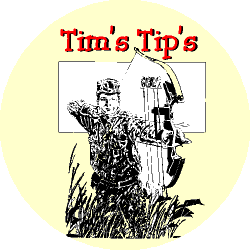Hunting Tips
 This month will be tips on setting up for bow hunting.
This month will be tips on setting up for bow hunting.
Bow hunting is the most challenging sport that there is, in my book.
Every thing can be perfect and then something goes wrong. Examples: The deer smells you, you miss
the shot, your bow makes noise, you just can't get a good shot, a squirrel or chipmunk is squawking at
you, I could go on and on about things that could go wrong.
I have four main rules on how to increase my odds of getting some venison in my freezer.
- You have to shoot, shoot and shoot some more! The more you practice, the better your chance is of
shooting a nice deer. When your knees are wobbling and your heart is pounding it is easier to
make the shot count by practicing. I try to shoot at least two times a week and at least two months
before hunting season. I shoot from all kinds of different spots. Examples: from my garage, my kids
tree fort, through brush, and sitting on the ground. I could go on and on. The more you practice the
better your odds are on getting a good shot on the animal that you are hunting.
- Playing the wind is another important part of deer hunting. When the wind is blowing the way
you are walking, the deer can smell and hear you. I found that the big bucks and does will try to get
down wind of feeding areas and bedding areas before coming into that area. One time I grunted a big
buck out of his bedding area and instead of coming straight toward me the buck circled around and
tried to get down wind of me. I had played the wind perfectly knowing that the buck would probably
try to get down wind of me. I positioned myself, knowing that the buck would stay in cover. The buck
walked right to me he was about 10 yards from me and then he saw me move. The deer never did hear
or smell me because I had played the wind perfectly.
- Late winter scouting and spring scouting. This is the best time to find out where the deer are
yarding up. This time of the year the deer gather for the winter. It seems the deer go to these areas
every winter. This depends on the food source. It is usually within one mile of the same area every
year. I found that in late fall when gun hunting pressure starts the deer will start moving towards these
spots. If there is no pressure the deer will stay in the area a lot longer. Sooner or later they make their
way to the winter hangout. That is a good time to intercept the deer for some late season bow hunting.
This spring I found a fencerow that had a rub-line for about a block. I got permission to hunt it.
This looks like a good late season bow hunting spot.
- Getting permission to hunt. In Minnesota it seems like it is getting harder and harder to get
permission to hunt on private land. But, you have to keep trying. I do a lot of my door pounding
in the spring when the farmers are waiting for the ground to thaw out and they are usually not too
busy. If you wait until fall, the farmers are usually busy harvesting their crops. I found one tip that
works sometimes is to bring kids along. I don't know why, but farmers like kids and kids like farms.
I found that farmers like it when you let them know that you only take good shots at the deer and
respect their land. I had a farmer tell me that he used to let bow hunters hunt his land but, one hunter
went into the neighbors land and got caught trespassing. He told the owner that he had permission
to hunt there. That was the last time the farmer let anyone hunt on his land. Remember, don't trespass
and have respect for other people's land.
Tips from Tim Worel
© copyright 1997 Tales of The Ultimate Sportsmen

